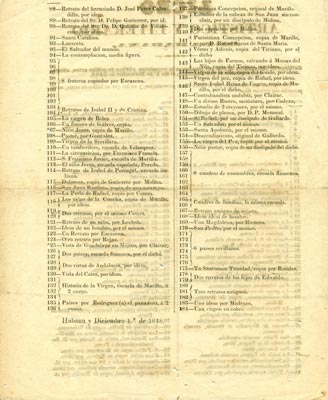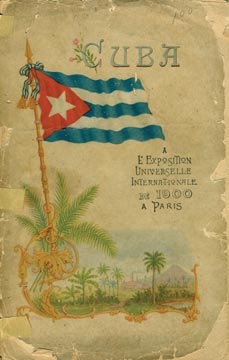According to astrophysics, a worm hole “Is ahypothetical topologic characteristic of time-space”; which means, in good Spanish, that for the time being everything is only a hypothesis and that, for the moment, we should also forget about time machines shown in Science Fiction movies produced in Hollywood and other areas. However, a file, no matter how small it might be, is an efficient way to transport us to the past without the risk to become mere spaghettis.
Today I made the decision to “travel” to the first file of the first drawer of my file cabinet and take out the copy of a document, pretty well saved by the way, that dates back to 1948. It is just the “Catalogue of Oil Paintings that make up the public exhibition of Noble Arts open in the Halls of this Institute, on December, 1948”, and which headline reads “Havana’s Artistic and Literary Lyceum”.1
 We look up in the useful Cuban Literature Dictionary, Book I and we can find:
We look up in the useful Cuban Literature Dictionary, Book I and we can find:
Havana’s ARTISTIC AND LITERARY LYCEUM. It was founded on September 15, 1844 by the initiative of José de Imaz, José Miró and Ramón Pintó, who, as members of the Santa Cecilia Philharmonic Society, founded in 1829, requested its transformation into a Lyceum to the Island Governor. His aim was to promote Letters and Fine Arts and, at the same time, to provide its Associates with amusement and entertainment. […] It was integrated the Sections of Literature and Language, Science, Music, Painting, Sculpture and Architecture and Recitation […]
The document in question is a sheet printed on both sides that, in spite of being 162 years old, it contains more information than many recent Exhibitions “Catalogues” which in a few years to come nobody will be able to know when, whom and for whom they were printed; therefore, we are in front of an excellent lesson to be learned from our ancestors. Nevertheless, this ancient document clearly shows the date of the inauguration (December 1st, 1848); the venue where it was exhibited (Havana’s Artistic and Literary Lyceum) and the total of Works presented to the public (184). Also, it makes a distinction the genera of the works as per the time’s criterion: portraits, still life, landscapes, religious themes, etc. It also reflects Schools: Italian, Spanish, Flemish, French.
The famous names of Raphael, Murillo, Velázquez, Tiziano and Rubens frequently appear on the list even if, with some exception, they are not mentioned like the authors of the exhibited works but as: Attributed to, Copy of and School of… The works to be sold have the price (ranged from 1 to 3 ounces).
Among the listed authors we only find two artists born in Cuba: Arturo Tomás Codezo (1834-1900) who exhibits a miniature named: “A Divine Face”, and José Cotera, student from San Alejandro School between 1846 and 1850, with a copy of Raphael and two Portraits.
This document by itself can be considered a valuable source of information about likes and customs of the time and it indicates the existence of an incipient collection habit in Havana by mid 19th Century. Even though we assume that most works were from small to medium format size -nothing is mentioned in this regard in the Catalogue- the quantity of works mentioned imply they should have occupied a big space, even with the high roof of the houses and the habit of piling up the paintings on the walls, one above of the other.
42 years pass until the next document in the file is found. This does not mean that no exhibitions were organized during those years. In fact, w have several references to exhibitions, even personal ones, organized in Havana and Santiago de Cuba, it is only that the documents are not in the file or they just did not exist at all. The document in question was printed to popularize and promote Cuban participation in L’Exposition Universelle Internationale de 1900 á Paris. It contains in details all agricultural, industrial, scientific, craft and artistic products that were exhibited at the Cuban Pavilion where, at the entrance there were two flags: the Cuban one to the right and the American one to the left2.
Precisely on the Cover page of this Catalogue a Cuban flag waving with the wind is shown while observing a rural landscape, created by a Cuban resident in Paris: Juan Ruiz y Ruiz. This painter is presented like a miniaturist and his work “Mephistopheles and Faust’s Pact” made on ivory. Twenty years later, in 1920, his name is found among exhibitors in the Fine Arts Hall of the Painters and Sculptures Association.
 The representation of Cuba totals twenty one painters and three sculptures with approximately forty works between oil paintings, drawings and carvings. Among the artists, Romañach and his work “The Convalescent” stands out. Years after it would be lost in a shipwreck in the Mississippi Rivers waters. Armando Menocal was also part of the Exhibition with a portrait of Mrs. Malpica. A lot of interest is also caused by the presence of a group of pictures from five authors which composition is attractive. The first one, Gregorio Casañas, was one of the photographers that worked in the battlefields of the War of 1995; he appears as based in Sagua la Grande. Other three: H.J. Miles ¿American? (Matanzas), Pedro J. Pérez (Cárdenas) and Calixto Ruiz de Castro (Matanzas) are represented by pictures and city views. The most popular of the group are from Havana, from Studio Otero Colominas, with a group of pictures of “Cuban Young Ladies”.
The representation of Cuba totals twenty one painters and three sculptures with approximately forty works between oil paintings, drawings and carvings. Among the artists, Romañach and his work “The Convalescent” stands out. Years after it would be lost in a shipwreck in the Mississippi Rivers waters. Armando Menocal was also part of the Exhibition with a portrait of Mrs. Malpica. A lot of interest is also caused by the presence of a group of pictures from five authors which composition is attractive. The first one, Gregorio Casañas, was one of the photographers that worked in the battlefields of the War of 1995; he appears as based in Sagua la Grande. Other three: H.J. Miles ¿American? (Matanzas), Pedro J. Pérez (Cárdenas) and Calixto Ruiz de Castro (Matanzas) are represented by pictures and city views. The most popular of the group are from Havana, from Studio Otero Colominas, with a group of pictures of “Cuban Young Ladies”.
On top of this, in Chapter XVII of this publication we find a very interesting data for the study of Art history in Cuba. It is a list of participation of the country in other World Exhibitions like Paris 1867, where two drawings and one painting were exhibited; Paris 1889, pictures and Chicago, 1893, sculpture.
The rest of the pages is a little encyclopaedia about Cuba, where figures related to Cuban production as well as existing companies and imported and exported products are abundant. In spite of the ten years that have passed since the edition of this Catalogue , it is in good state of conservation and can be easily consulted even though, unfortunately, it does not contain any reproductions of the works exhibited at the Cuban pavilion. ¿Isn’t it true that these documents are real Worm Holes?
1As soon as this Institution was founded on February 1845, a Painting and Sculpture Exhibition is organized. There is no information about this Exhibition. It is possible it can be found in the National Archives Fund of Cuba.
2Cuba is not independent from the United Status until May 20, 1902.
Related Publications

How Harumi Yamaguchi invented the modern woman in Japan
March 16, 2022












